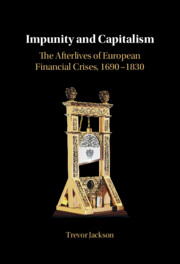6 - The Panic of 1825 and the Systematization of Impunity
from Part III - Preface
Published online by Cambridge University Press: 08 September 2022
Summary
Unlike 1720 or 1793–97, the bubble of the 1820s was generated by the financial system itself: The new expansion of the banking system both domestically and internationally, the Bank of England’s monetary policies, the structure of corporate finance, and sovereign lending practices produced the bubble without any need for malfeasance or exogenous shocks. The bubble burst in late 1825, leading to the failure of more than 100 British banks and more than 1.000 businesses. At the height of the Panic of 1825, the decision about priorities and interests was taken not by a political sovereign or a regulatory legal institution, but by a private bank: Rothschilds bailed out the Bank of England, showing the power of financial markets over governance. For the first time, it was clear that financial markets could both cause and end financial crises regardless of political institutions. After 1825, financial crises became a predictable and intelligible part of life, caused by impersonal and abstract international markets, managed by central banks independent of political accountability, explained and analyzed by a self-authorized body of economic thought, with the costs borne by domestic populations and nobody in particular at fault.
Keywords
- Type
- Chapter
- Information
- Impunity and CapitalismThe Afterlives of European Financial Crises, 1690–1830, pp. 219 - 259Publisher: Cambridge University PressPrint publication year: 2022

